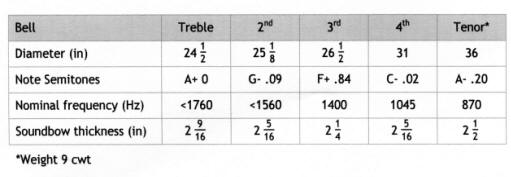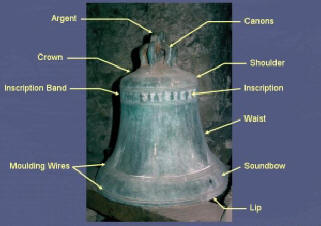|
St Mary's Bells |
|||
|
The bell chamber The topmost stage of the central tower of the church – houses a ‘ring’ of five bells, installed in 1901. A brass plate on the wall beside the vestry door tells us that, “The clock & chimes in the tower were erected to the Glory of God and in memory of Mr John Rowland, who died in this church 3rd September 1899.” The ring is in fact a clock chime of five bells rung both by hand and from the turret clock in the ringing chamber beneath the bell chamber. The bells are hung dead in two rows. That is to say, they can not be rung ‘full-circle’ by a team of ringers, but are instead chimed from the clock mechanism and from an Ellacombe frame (see below) also in the ringing chamber. Another rope passes down to the vestry for tolling the tenor bell for church services and at funerals and weddings. Clouston's Survey The details of the bells are summarised in the following table written in 1980 by the renowned bell expert Ranauld W M Clouston, BSc (Eng), FSA.
Clouston adds the following information. For the technical terms, please see the photograph (by courtesy of the Central Council of Church Bell Ringers).
"The three larger bells are maiden castings in that they have not been tuned after casting. The two trebles have been hand-chipped in the soundbows to flatten the strike notes. In 1901 the principal bell founders in England tuned their bells by turning off metal in a type of lathe, so this means that these bells were not cast at the Whitechapel Bell Foundry, or by Taylors of Loughborough, Gillett & Johnston of Croydon or Warners of London. "They are well cast, clearly by the same firm, who were experienced bell founders, and the evidence points to James Barwell of Birmingham, or less likely to Charles Carr of Smethwick, and a date of about 1901. "One odd feature is that the treble is thicker in the soundbow than any of the others. There is a peculiar lip on third bell, as cast, not machined. "In the corner of the bell chamber is a timber frame for a bell of up to 20 ins diameter to be hung for swing chiming. This could have been for the bell from the older church built in 1821 which had a small open bellcote. This bell has gone.” Westminster Chimes
The name of the chime has its origins in a musical arrangement written in 1793 for the clock at the church of Great St Mary in Cambridge, here illustrated in the key of E major although the bells at Goathland are actually in A major. This arrangement was later selected for the clock built in 1859 at the Palace of Westminster, whose tower acquired its popular name from its largest bell, Big Ben, but has recently been renamed the ‘Elizabeth Tower’ to celebrate Her Majesty the Queen’s Diamond Jubilee. As a result of the new clock, the ‘Westminster Chimes’ became hugely popular for chiming timepieces ranging from pocket watches to large turret clocks [i.e. tower clocks like Goathland’s]. An advantage was that it required only five bells rather than, for example, the eight required for Whittington Chimes – a frequently encountered alternative in chiming clocks. Ellacombe bell apparatus
A pivoted Ellacombe hammer is fixed beside each bell, striking up against the inside of the soundbow, the ropes from all the hammer tails being led down through pulleys and secured on ratchet drums on a frame on the wall of the ringing chamber. Each rope is independently tensioned to ensure an even action, and when ringing is finished, the tension is relaxed to ease the tension on the vestry tolling rope. The photograph shows Goathland’s steel frame, made by bellfounders Taylor and Co of Loughborough, measuring 27 inches wide by 32 inches high, with pulleys, ropes, and the winding squares of the ratchet tensioners. The movable handle is shown on the square of the tenor bell rope. A bell is played by ‘plucking’ its rope forward a little from the frame, which pulls on the hammer tail and sounds the bell. Whereas the Ellacombe hammers strike upwards, the clock hammers strike downwards on to the outside of the soundbow. The ringer simply follows a pattern written on a ‘change board’. Without repeats, a full peal or ‘extent’ on a frame of five offers a theoretical total of 120 permutations, or ‘changes’ (5 x 4 x 3 x 2 x 1), which would last for about twelve minutes. Change boards for several rings are available, with names such as “Plain hunt on 5 bells”, or “Plain hunt with tenor (5) behind.” A specimen change board with an abbreviated peal is shown beside the frame. |
|||
|
|||

 “The bells
are completely without inscription or mark. Each has six angular
canons round a normal argent and in the centre has a square hole for
an independent crown staple [the device from which the clapper is
suspended]. Large half-round moulding wires [raised bands]
are arranged 2, 2-2, 3-2 (up) [ie in pairs and threes] except
on the tenor, which has 3, 2-2, 4-2.
“The bells
are completely without inscription or mark. Each has six angular
canons round a normal argent and in the centre has a square hole for
an independent crown staple [the device from which the clapper is
suspended]. Large half-round moulding wires [raised bands]
are arranged 2, 2-2, 3-2 (up) [ie in pairs and threes] except
on the tenor, which has 3, 2-2, 4-2. While five
bells is a relatively unusual number for an ordinary ring, it is
dictated here by the chiming scheme, in this instance Cambridge
Quarters, perhaps better known as Westminster Chimes. This is a
pattern of chimes sounded at the quarters of the hour, its four
phrases being sounded twice each during the hour. At the hour, the
hour is struck on the Tenor (lowest pitch) bell.
While five
bells is a relatively unusual number for an ordinary ring, it is
dictated here by the chiming scheme, in this instance Cambridge
Quarters, perhaps better known as Westminster Chimes. This is a
pattern of chimes sounded at the quarters of the hour, its four
phrases being sounded twice each during the hour. At the hour, the
hour is struck on the Tenor (lowest pitch) bell.